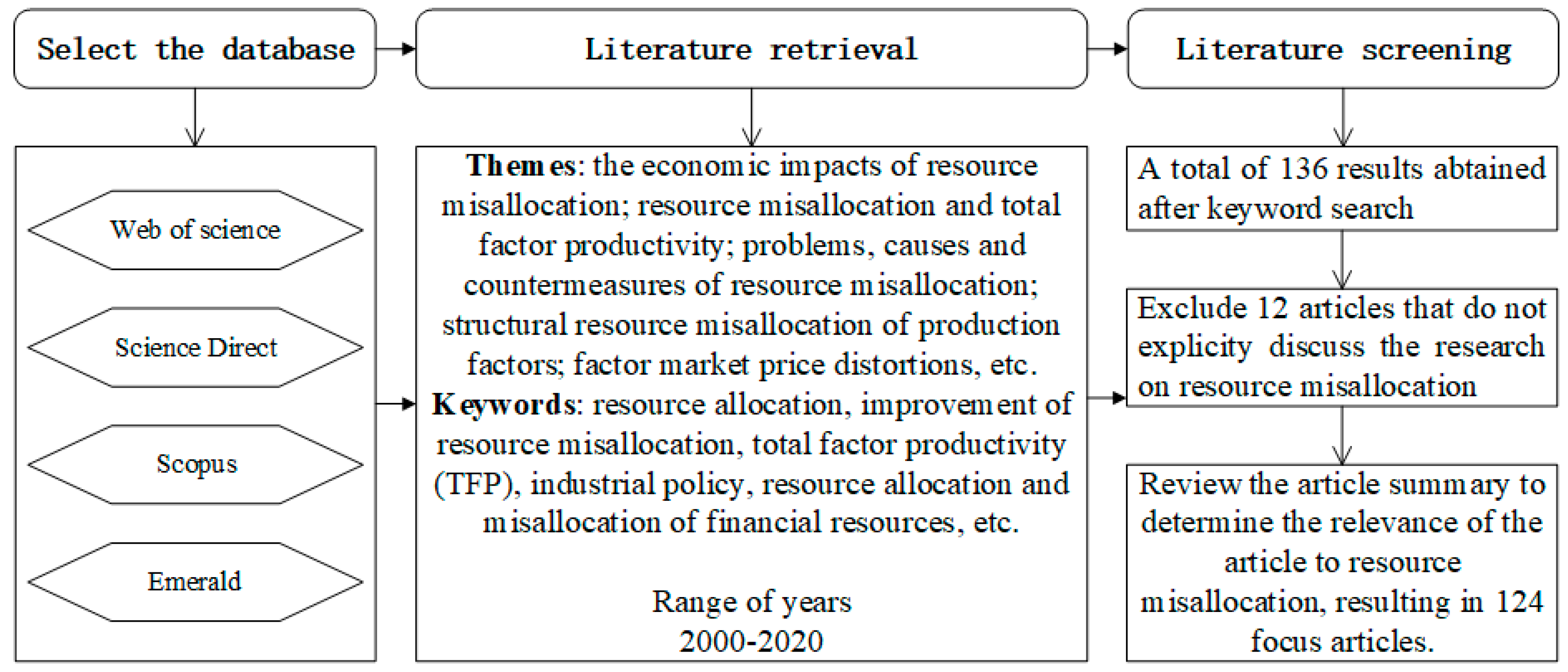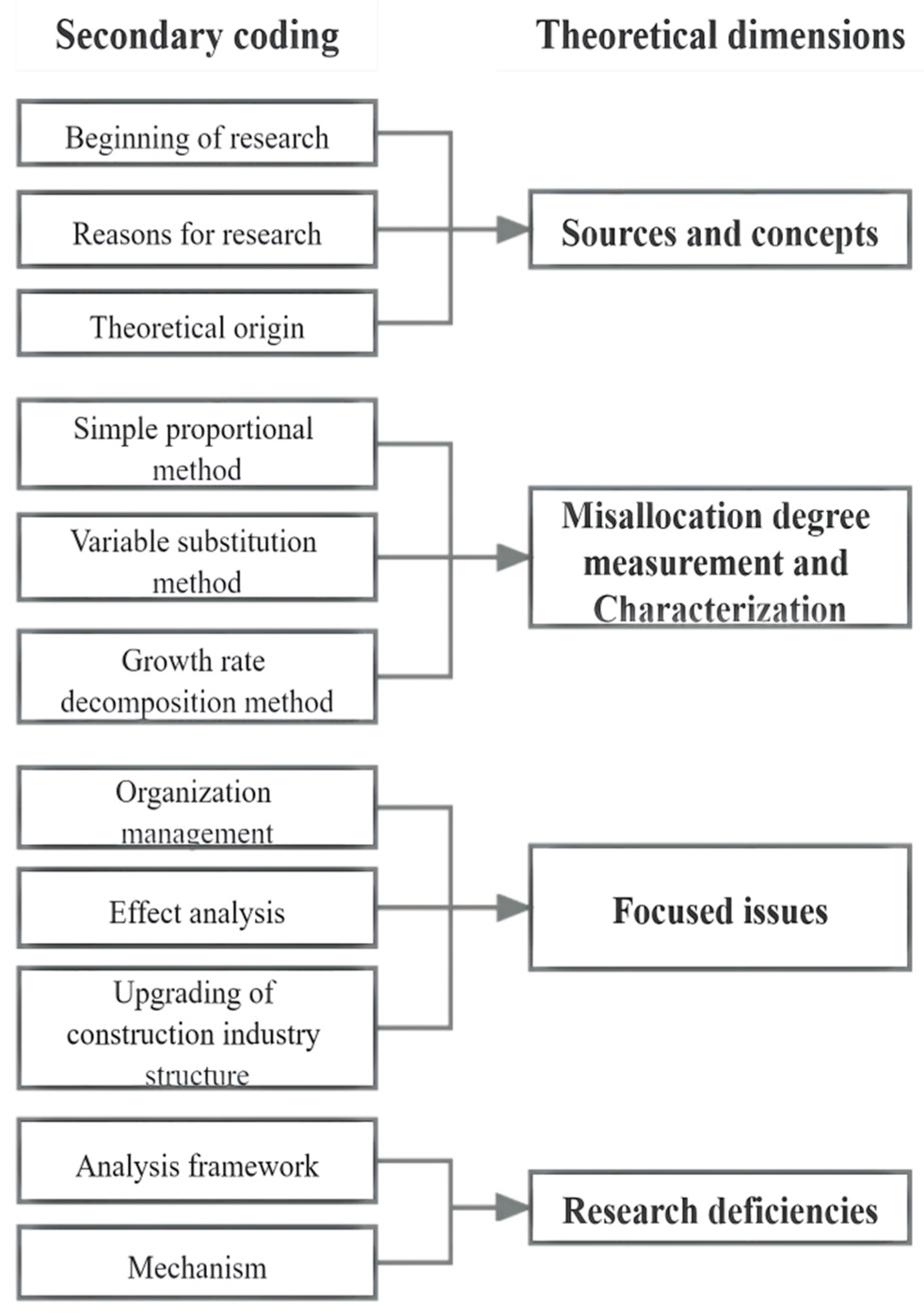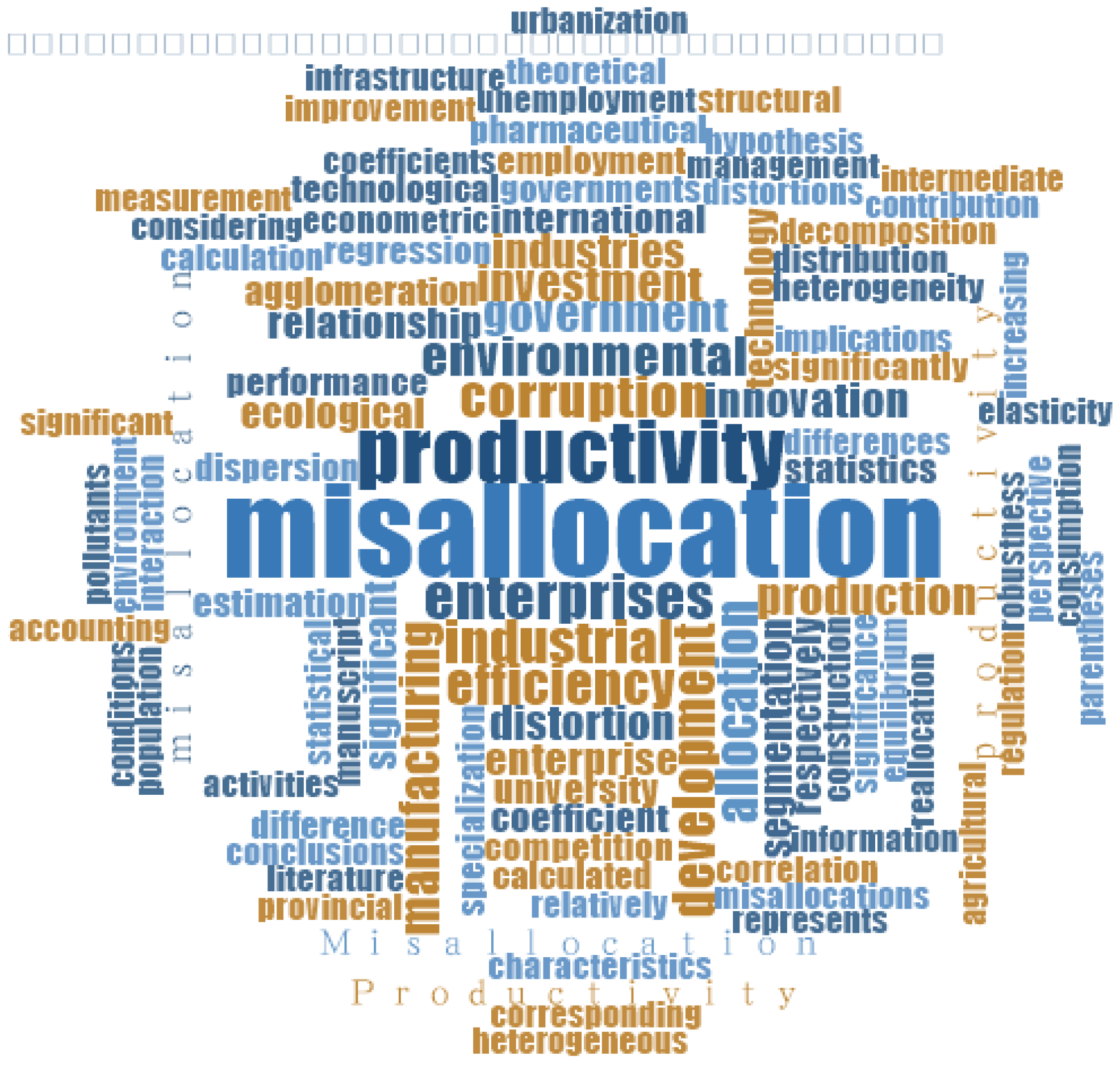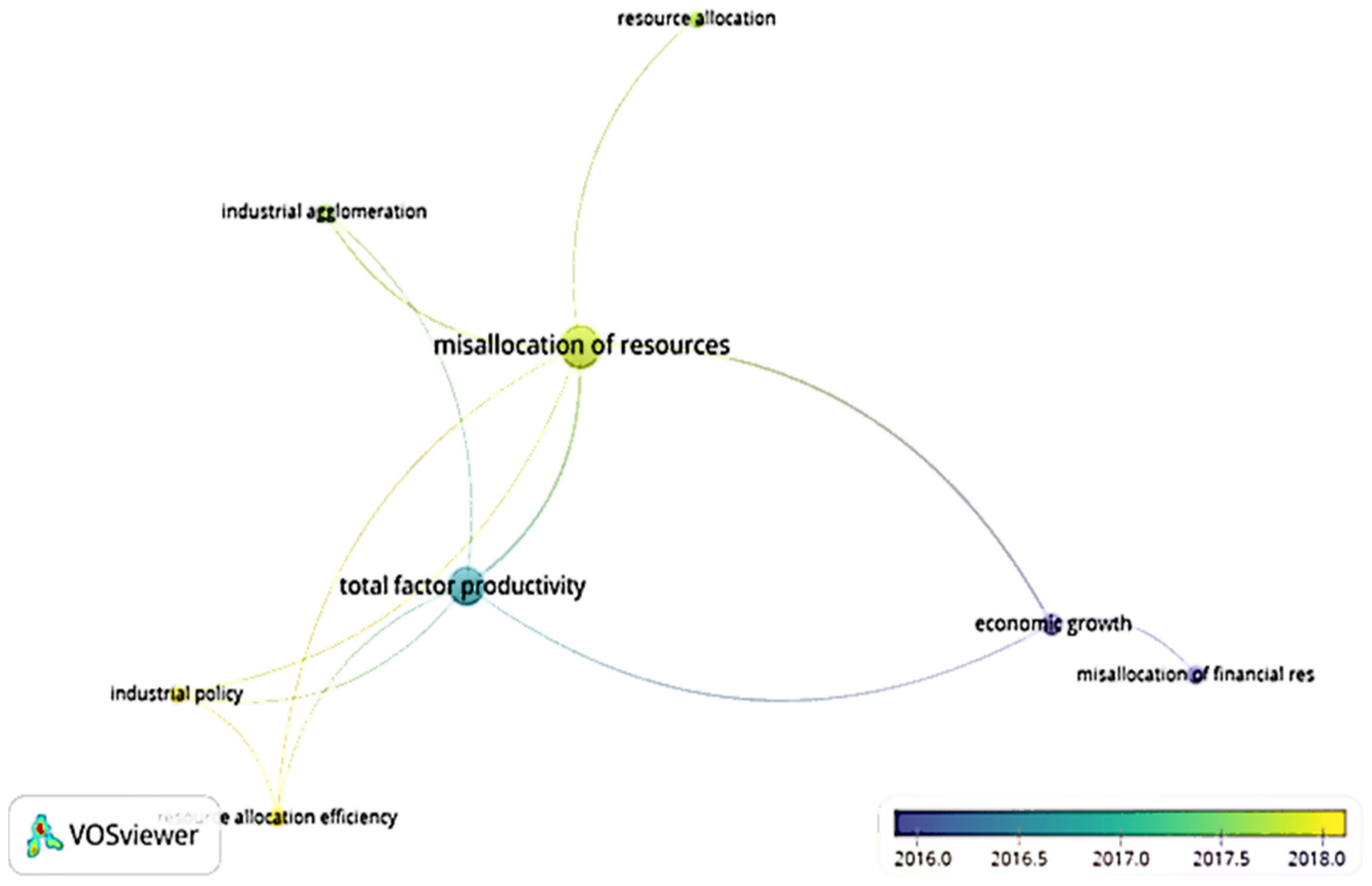Current and Future Trends of Resource Misallocation in the Construction Industry: A Bibliometric Review with Grounded Theory
Abstract
1. Introduction
2. Research Methods
2.1. Data Collection
2.2. Description of Methods Used
3. Results
3.1. Open Coding—Primary Related Factors of RM
- Organizational operation efficiency and regulation, whether the enterprise can overcome financial constraints and the degree of impact of resource mismatching output, control the entry of new enterprises, support or suppress construction companies, and various other government policies;
- Insufficient functional mechanisms and analytical frameworks, research reasons, such as allocating resources through state-owned enterprises instead of the market, economic restructuring costs, trade costs, the informal sectors presence, and resource allocation based on human talent;
- The beginning of the research and the theoretical origin;
- The methods of calculating the RM, such as growth rate decomposition, simple proportional, and variant substitution at the bottom of the subordinate relationship.
3.2. Associative Coding—A Structural Model for RM Research
3.3. Selective Coding—The RM Research Core
- (1)
- Sources and concepts
- (2)
- Focused issues
- (3)
- Methods of misallocation degree measurement
3.4. Saturation Test
4. Discussion and Implications
4.1. Discussion
- Current RM-related research involves a three-layer structural model. The first layer analyzes and describes the macro elements of RM. This layer contains 4 nodes in total: sources and concepts, misallocation degree measurement and characterization, focused issues, and research deficiencies. The second layer involves the study of intermediate elements and most of the RM direct elements. This contains 11 nodes: research beginning, the reason for the research, and the theoretical origin; the simple ratio method, the growth rate decomposition method, and the variable substitution method; the organization management, the upgrading of construction industry structure, and the effect analysis; and insufficient research on the mechanism of action and framework of analysis. Each node has a different influence and has also experienced a different amount of research activity
- Focused issues and misallocation degree measurement and characterization are the “core categories” for exploring the RM problem, while sources, concepts, and research deficiencies are the “supported categories”. The latter are not explained in this paper because their impact on RM is minimal. The research on the current and future trends of resource misallocation in the construction industry also has no core value.
- With more RM-related research being developed and the updating and maturity of economic theoretical models, more methods for measuring RM have also been developed. These range from the simple proportional method to current mainstream methods (e.g., growth rate decomposition and variant substitution). This makes it possible to further analyze quantitatively the impact of RM changes in specific industries, including from BIM to extended reality (VR, AR, MR, Digital Twins, Data capturing technologies, etc.) in AEC industry. It also allows the factors that condition production efficiency between industries to be better understood.
4.2. Implications
5. Conclusions
Author Contributions
Funding
Conflicts of Interest
References
- Eric, J.; Bartelsman, J.C.H.; Scarpetta, S. Cross-Country Differences in Productivity. Role Alloc. Sel. Am. Econ. Rev. 2013, 103, 305–334. [Google Scholar]
- Caselli, F. Accounting for Cross-Country Income Differences. LSE Res. Online Doc. Econ. Available online: https://www.sciencedirect.com/science/article/abs/pii/S1574068405010099 (accessed on 4 August 2022).
- Solow, R.M. Technical Change and Aggregate Production Function. Rev. Econ. Stat. 1957, 39, 312–320. [Google Scholar] [CrossRef]
- Jing Hang, K.G.; Niu, M. Resource mismatch, capacity utilization and productivity. Economics 2021, 20. [Google Scholar]
- Loren Brandt, T.T.; Zhu, X. Factor market distortions across time, space and sectors in China. Rev. Econ. Dyn. 2013, 16, 39–58. [Google Scholar] [CrossRef]
- Bai, Y. Research on the Transformation of my country’s Industrial Economic Structure under the New Normal. Trade Show Econ. 2020, 8, 86–88. [Google Scholar] [CrossRef]
- Song, J. An Analysis of the Causes and Countermeasures of Resource Misallocation in China’s Economic Transformation. J. Shandong Inst. Bus. Technol. 2021, 35, 11. [Google Scholar] [CrossRef]
- Khan, A.; Sepasgozar, S.; Liu, T.; Yu, R. Integration of BIM and Immersive Technologies for AEC: A Scientometric-SWOT Analysis and Critical Content Review. Buildings 2021, 11, 126. [Google Scholar] [CrossRef]
- Mishlanova, M.; Patrina, T.Y.; Chekunova, A. Life cycle model material resources in the construction industry. Bull. Belgorod State Technol. Univ. Named After. V. G. Shukhov 2017, 2, 236–241. [Google Scholar] [CrossRef]
- Anelauskas, J. Impact of Innovations on Human Resources in the Construction Industry. Available online: https://www.semanticscholar.org/paper/Impact-of-innovations-on-human-resources-in-the-Anelauskas/0b5439fd09c12159774662f91cb05c0a6b98b1cf. (accessed on 14 August 2022).
- Fisunenko, N. Evaluation Market Investment Resources in Construction Industry. Available online: https://echas.vnu.edu.ua/index.php/echas/article/view/104 (accessed on 26 August 2022).
- Piri, L.; Ghezavati, V.; Hafezalkotob, A. Developing a new model for simultaneous scheduling of two grand projects based on game theory and solving the model with Benders decomposition. Front. Eng. Manag. 2022, 9, 117–134. [Google Scholar] [CrossRef]
- Richard, J.; Adams, P.S.; Huff, A.S. Shades of Grey: Guidelines for Working with the Grey Literature in Systematic Reviews for Management and Organizational Studies. Int. J. Manag. Rev. 2017, 19, 432–454. [Google Scholar] [CrossRef]
- Li, Z. Analysis on the Application of Grounded Theory Method in Scientific Research. Orient. Forum. J. Qingdao Univ. 2007, 4, 90–94. [Google Scholar]
- Pandit, N.R. The creation of theory: A recent application of the grounded theory method. Qual. Rep. 1996, 2, 1–15. [Google Scholar] [CrossRef]
- Maocong Zhang, W.Z. On the Construction of my country’s Crisis Education Content—Based on Nvivo Analysis of 32 Core Documents Since 2003. Courses. Teach. Materials. Teach. Methods. 2020, 3, 8. [Google Scholar]
- Yifan Qin, F.L.; Li, J.; Wang, K.; Du, Z.; Xu, H. Investigation and Research on Doping Abuse in Adolescents of Physical Education College Students—A Qualitative Research Based on Grounded Theory. In Proceedings of the Collection of Abstracts of Papers of the 11th National Sports Science Conference, Nanjing, China, 1–3 November 2019; 2019; 10, p. 1. [Google Scholar]
- Alessandro Pepe, L.A.; Veronese, G.; Glăveanu, V. Measuring Teacher Job Satisfaction: Assessing Invariance in the Teacher Job Satisfaction Scale (TJSS) Across Six Countries. Eur. J. Psychol. 2017, 13, 396–416. [Google Scholar] [CrossRef] [PubMed]
- Lenzu, S.; Manaresi, F. Sources and implications of resource misallocation: New evidence from firm-level marginal products and user costs. Quest. Di Econ. E Finanz 2019. [Google Scholar] [CrossRef]
- Jeffers, J.R.; Bognanno, M.F.; Bartlett, J.C. On the demand versus need for medical services and the concept of "shortage". Am. J. Public Health 1971, 61, 46–63. [Google Scholar] [CrossRef][Green Version]
- Syrquin, M. Resource reallocation and productivity growth. Econ. Struct. Perform. Available online: https://www.sciencedirect.com/science/article/pii/B9780126800609500118 (accessed on 1 August 2022).
- Jwa, S.H. Globalization and New Industrial Organization: Implications for Structural Adjustment Policies. In Regionalism Versus Multilateral Trade Arrangements; University of Chicago Press: Chicago, IL, USA, 1997; NBER Chapters 1997; pp. 313–344. [Google Scholar]
- James, A.R.; Torvik, R.; Verdier, T. Political foundations of the resource curse. J. Dev. Econ. 2006, 79, 447–468. [Google Scholar] [CrossRef]
- Hsieh, C.T.; Klenow, P.J. Misallocation and Manufacturing TFP in China and India. Q. J. Econ. 2009, 124, 1403–1448. [Google Scholar] [CrossRef]
- Zhigang Yuan, D.X. Coordinating Urban and Rural Development: Coordinated Reallocation of Human Capital and Land Capital. Res. Social. Chin. Charact. 2011, 2, 31–42. [Google Scholar]
- Yongwei Chen, W.H. Price distortion, factor mismatch and efficiency loss: Theory and application. Economics 2011, 10, 22. [Google Scholar]
- Deming Luo, Y.L.; Shi, J. Factor market distortion, resource misplacement and productivity. Econ. Res. 2012, 47, 4–14+39. [Google Scholar]
- Huihua Nie, R.J. Productivity and Resource Misplacement of Chinese Manufacturing Enterprises. World Econ. 2011, 34, 27–42. [Google Scholar]
- Zhen Yang, Y.C. China’s manufacturing resource misplacement and welfare loss measurement. Econ. Res. 2013, 48, 43–55. [Google Scholar]
- Wang, S.; Sun, X.; Song, M. Environmental Regulation, Resource Misallocation, and Ecological Efficiency. Emerg. Mark. Financ. Trade 2021, 57, 410–429. [Google Scholar] [CrossRef]
- Kong, Q.; Peng, D.; Zhang, R.; Wong, Z. Resource misallocation, production efficiency and outward foreign direct investment decisions of Chinese enterprises. Res. Int. Bus. Financ. 2021, 55, 101343. [Google Scholar] [CrossRef]
- Buera, F.J.; Kaboski, J.P.; Shin, Y. Finance and Development: A Tale of Two Sectors. Am. Econ. Rev. 2011, 101, 1964–2002. [Google Scholar] [CrossRef]
- Abhijit, V.; Banerjee, B.M. Why Does Misallocation Persist? Am. Econ. J. Macroecon. 2010, 2, 189–206. [Google Scholar]
- Pan, Y. Focus on and solve the problem of financial resource mismatch from a strategic height. Explor. Contention 2016, 93–98. [Google Scholar]
- Asker, J.; Collard-Wexler, A.; Jan De, L. Productivity Volatility and the Misallocation of Resources in Developing Economies. CEPR Discussion Papers. Available online: https://www.nber.org/papers/w17175 (accessed on 21 August 2022).
- Lewandowskakalina, M. Productivity Dispersion and Misallocation of Resources: Evidence from Polish Industries. Economics. Available online: https://ideas.repec.org/p/wse/wpaper/66.html (accessed on 5 August 2022).
- Restuccia, D. Rogerson, Richard Misallocation and productivity. Rev. Econ. Dyn. 2013, 16, 1–10. [Google Scholar] [CrossRef]
- Virgiliu Midrigan, D.Y.X. Finance and Misallocation: Evidence from Plant-Level Data. Am. Econ. Rev. 2014, 104, 422–458. [Google Scholar] [CrossRef]
- Ziebarth, N.L. Are China and India Backwards? Evidence from the 19th Century U.S. Census of Manufactures. Soc. Econ. Dyn. 2013, 16, 138. [Google Scholar] [CrossRef]
- Guner, N.; Ventura, G.; Xu, Y. Macroeconomic Implications of Size-Dependent Policies. Rev. Econ. Dyn. 2017, 11, 721–744. [Google Scholar] [CrossRef]
- Barseghyan, L.; Dicecio, R. Entry costs, industry structure, and cross-country income and TFP differences. J. Econ. Theory 2009, 146, 1828–1851. [Google Scholar] [CrossRef]
- Repetto, A.; Micco, A. Productivity, Misallocation and the Labor Market. Economics. Available online: https://ideas.repec.org/p/uai/wpaper/wp_020.html (accessed on 10 August 2022).
- Bai, D. Distortion of industrial policy, market allocation and misallocation of regional resources. In Proceedings of the Modern Economic System and High-Quality Development-the 13th China Development Economics Annual Conference, Lanzhou, China, 5 March 2021; 2019; Volume 6, p. 1. [Google Scholar]
- Jac, A.; Mg, B.; Al, C.; Fp, B. Environmental misallocation in the copper industry—ScienceDirect. Resour. Policy 2021, 71, 102003. [Google Scholar] [CrossRef]
- Sahin, A.; Song, J.; Topa, G.; Violante, G.L. Mismatch in the Labor Market. Available online: https://users.nber.org/~confer/2011/EFGf11/Sahin_Song_Topa_Violante.pdf (accessed on 26 August 2022).
- Sargent, T.; Manuelli, R. Instability, Misallocation and Productivity. In Proceedings of the 2013 Meeting Papers. Available online: https://ideas.repec.org/p/red/sed013/1043.html (accessed on 16 August 2022).
- Xiaolan Deng, Z.Y. The Impact of Misallocation of Resources on China’s Industrial Low-carbon TFP: An Empirical Study. Financ. Sci. 2014, 5, 74–83. [Google Scholar]
- Ai Ma, J.Z.; Yu, J.; Xu, H. Does the mismatch of labor factors hinder the upgrading of the industrial structure? In Proceedings of the Modern Economic System and High-Quality Development-the 13th China Development Economics Annual Conference, Lanzhou, China, 5 March 2021; 2019; Volume 6, p. 1. [Google Scholar]
- Wang, W.Z.S.; Niu, Z. Industrial Policy, Market Competition and Resource Mismatch. Economist 2014, 9, 22–32. [Google Scholar] [CrossRef]
- Brandt, L.B.; Johannes, V.B.; Yifan, Z. Creative Accounting or Creative Destruction? Firm-Level Productivity Growth in Chinese Manufacturing. J. Dev. Econ. 2012, 97, 339–351. [Google Scholar] [CrossRef]
- Puyang Sun, W.J.; Zhang, Y. Product Substitution and Productivity Distribution: An Empirical Study Based on Data from Chinese Manufacturing Enterprises. Econ. Res. 2013, 48, 30–42. [Google Scholar]
- Guan Gong, G.H. Resource Allocation Efficiency and Total Factor Productivity of China’s Manufacturing Industry. Econ. Res. 2013, 48, 4–15+29. [Google Scholar]
- Ariel Pakes, S.O. A limit theorem for a smooth class of semiparametric estimators. J. Econom. 1995, 65, 295–332. [Google Scholar] [CrossRef][Green Version]
- Nordhaus, W.D. Productivity Growth and the New Economy. Brook. Pap. Econ. Act. 2002, 2002, 211–265. [Google Scholar] [CrossRef]
- Yang, C. Research Progress and Frontier Analysis of Resource Mismatch. China Sci. Technol. Resour. Guide 2020, 52, 9. [Google Scholar] [CrossRef]
- Barney, G.; Glaser, A.L.S.; Strutzel, E. The Discovery of Grounded Theory; Strategies for Qualitative Research. Nurs. Res. 1968, 17, 364. [Google Scholar]









| Research Direction | Research Connotation | Key Literature |
|---|---|---|
| TFP | TFP as a measure of technological progress to explain the efficient functioning of an economy and ways to improve its productivity. | Solow [4] |
| Assess the scope of input misallocation in Italy and its impact on aggregate output and TFP. | Lenzu [19] | |
| Shortage of service demand | Differentiate between the concepts of “need” and “demand” for medical services and provide a concept of “shortage” in this context. | Jeffers [20] |
| TFP growth decomposition | Decompose TFP growth into the industry’s own TFP growth and the allocation effect of factors among industries. | Syrquin [21] |
| Structural adjustment policies | Any anti-diversification policy directly limiting the realm or range of business activities without correcting the business environment may not be effective and will create serious RM. | Jwa [22] |
| Misallocation in various fields | Resource prosperity increases the value of power by providing more resources for politicians and exacerbating misallocation in various fields. | James A [23] |
| Concept formation | Provide a new analytical perspective for TFP growth. | Hsieh [24] |
| Enterprise productivity | Imperfect market mechanisms exacerbate the distortion of allocation of and enterprise factors, and restrict improvement in enterprise production efficiency. | Zhigang Yuan [25] Yongwei Chen [26] Deming Luo [27] Huihua Nie [28] Zhen Yang [29] |
| Changes in ecological efficiency | Environmental regulation and RM factors are introduced to identify the key factors influencing ecological efficiency. | Wang [30] |
| Outward foreign direct investment (OFDI) | RM, as an essential characteristic of China’s “progressive reform”, has become a significant factor restricting high-quality OFDI. | Kong [31] |
| First Level Node | Secondary Nodes | Three-Level Nodes | Number of Coding Reference Points |
|---|---|---|---|
| Sources and concepts (3) | Beginning of research | 5 | |
| Reasons for research | Allocate resources through state-owned enterprises instead of the market | 5 | |
| Economic restructuring costs | |||
| Trade costs | |||
| Presence of the informal sector | |||
| Cannot allocate resources based on human talents | |||
| Theoretical origin | 13 |
| Research Direction | Research Connotation | Key Literature | ||
|---|---|---|---|---|
| Effect analysis | Overcoming the impact of | Financial friction | Financial market friction causes the misallocation of resources in the initial stage, which greatly hinders the convergence of high-speed growth to a steady-state equilibrium path. | Francisco J Buera [32] |
| Enterprises can accumulate enough capital and self-correct the “first type of misallocation” caused by financial market friction. | Abhijit V. Banerjee [33] | |||
| Corporate debt | Reveal the truth of the decline of investment efficiency and the misallocation of financial resources behind the deviation between the asset-liability ratio and the macro-debt ratio of Chinese enterprises. | Pan [34] | ||
| Impact on outputs | TFP dispersion and impact | The dynamic process of controlling productivity shocks determines misallocation and income disparities. | Asker [35] | |
| Productivity gap among enterprises | RM among enterprises is an important reason for a low TFP. | Lewandowskakalina [36] | ||
| TFP differences among countries | The redistribution of factors between heterogeneous production units is an important source for measuring TFP differences between countries. | Restuccia [37] | ||
| Impact on productivity | The misallocation caused by financial market distortions can explain 10% of the total misallocation at most, and its impact is minimal. | Abhijit V. Banerjee [33] Virgiliu Midrigan [38] | ||
| Market distortions | Operating effectiveness | The effectiveness of market operations has an impact on the cost of capital acquisition, allocation efficiency, and entrepreneurial behavior by enterprises. | Buera [32] | |
| Market malfunction | Banking system malfunctions will increase RM. | Ziebarth [39] | ||
| Upgrading of construction industry structure | Scale control | Policies restricting large enterprises and supporting SMEs have depressed the scale of enterprises in the economy and caused a misallocation of resources in low-productivity SMEs. | Guner [40] | |
| Construction organizations | RM of manufacturing policy will reduce TFP. | Hsieh [24] | ||
| Entry regulation | The countries with loose entry regulations have higher TFP levels and productivity than strictly regulated countries. | Barseghyan [41] | ||
| Inappropriate organizational policy | Inappropriate industrial organization policies distort resource allocation and cause serious misallocation and loss of TFP and output. | Repetto [42] | ||
| Development zone evaluation | Improved system efficiency can alleviate the policy impact of development zones on the misallocation of regional resources. | Bai [43] | ||
| Government intervention and special rules | The level reached by social planners that allocate the current aggregate output across mines, so as to minimize emissions, conditional on some well-defined extraction rules. | Jac [44] | ||
| Organization management | Market distortion | Assesses the degree and impact of distortions in the construction market. | Chang-Tai Hsieh [24] | |
| Job supply and demand | A serious mismatch between job supply and demand will cause a large number of laborers to be “misallocated” and become unemployed, thereby raising the labor cost of construction enterprises. | Sahin [45] | ||
| Entrepreneur or worker decisions | Fluctuations in input prices lead to the misallocation of talent between entrepreneurs and the salaried sector. | Sargent [46] | ||
| Labor allocation in the construction industrial sector | Increased labor-misallocation of resources significantly hampers low-carbon productivity gains. | Xiaolan Deng [47] | ||
| Internal influence mechanisms of labor allocation | Guiding the diversion and transfer of labor resources according to local conditions and improving allocation efficiency will provide human and capital support for the optimization and upgrade of construction industrial structure. | Ai Ma [48] | ||
| First Level Node | Secondary Nodes | Three-Level Nodes | Coding Reference Points |
|---|---|---|---|
| Focused issues (3) | Effect analysis (main node) | Overcoming financial constraints | 83 |
| Impact on outputs | |||
| Upgrading construction industry structure | Control the entry of new businesses | 50 | |
| Support or suppress construction companies | |||
| Other government policies | |||
| Organization management | Organizational efficiency | 34 | |
| Corporate regulation |
| Period | High-Frequency Words (Valid Words and Weighted Percentage Higher than 0.5%) | Research Focuses |
|---|---|---|
| 2010–2015 | Enterprises, resources, industries, factors, allocation, productivity, economy, capital, China. | Enterprise productivity; TFP; distortion of resource allocation. |
| 2016–2020 | Resources, enterprises, economy, allocation, elements, industry, capital, industry, China. | Market distortion and misallocation of resources; influence of RM on TFP; misallocation of factors caused by industrial structure imbalance. |
| Research Direction | Research Connotation | Key Literature | |
|---|---|---|---|
| Simple proportion method | TFP ratio of 90/10 enterprises | 90/10 of all state-owned and above-scale enterprises have decreased and their average TFP increased year by year. | Huihua Nie [28] |
| 75/25 quantile difference | The degree of misallocation can be measured by productivity dispersion but may be interfered with by endogenous and selective change. | Puyang Sun [51] | |
| Variable substitution method | Use TFP to measure the degree of distortion of resource allocation across enterprises. | Klenow [24] | |
| Incorporate the cost of using elements into the analytical framework for studying misallocation. | Zhen Yang [29] | ||
| Marginal product income of production factors as a tool to measure the allocation distortion. | Guan Gong [52] | ||
| Growth rate decomposition method | Efficiency loss | Decompose TFP into technical efficiency, resource allocation efficiency, and economies of scale. | Ariel Pakes [53] |
| Decompose the TFP growth rate into the industry’s internal productivity growth effect, the positive effect of output share on productivity growth, and the resource reallocation effect. | Nordhaus [54] | ||
| China’s construction industry has a strong dependence on intermediate products. The introduction of intermediate input factors is more indispensable when studying the TFP and the growth of the specific sector. | Zhen Yang [29] | ||
| First Level Node | Secondary Nodes | Coding Reference Points |
|---|---|---|
| Misallocation degree measurement and characterization (3) | Simple proportional method | 5 |
| Variant substitution method (main node) | 52 | |
| Growth rate decomposition method | 10 |
Publisher’s Note: MDPI stays neutral with regard to jurisdictional claims in published maps and institutional affiliations. |
© 2022 by the authors. Licensee MDPI, Basel, Switzerland. This article is an open access article distributed under the terms and conditions of the Creative Commons Attribution (CC BY) license (https://creativecommons.org/licenses/by/4.0/).
Share and Cite
Zhang, J.; Dong, F.; Ballesteros-Pérez, P.; Li, H.; Skitmore, M. Current and Future Trends of Resource Misallocation in the Construction Industry: A Bibliometric Review with Grounded Theory. Buildings 2022, 12, 1731. https://doi.org/10.3390/buildings12101731
Zhang J, Dong F, Ballesteros-Pérez P, Li H, Skitmore M. Current and Future Trends of Resource Misallocation in the Construction Industry: A Bibliometric Review with Grounded Theory. Buildings. 2022; 12(10):1731. https://doi.org/10.3390/buildings12101731
Chicago/Turabian StyleZhang, Jingxiao, Fangyu Dong, Pablo Ballesteros-Pérez, Hui Li, and Martin Skitmore. 2022. "Current and Future Trends of Resource Misallocation in the Construction Industry: A Bibliometric Review with Grounded Theory" Buildings 12, no. 10: 1731. https://doi.org/10.3390/buildings12101731
APA StyleZhang, J., Dong, F., Ballesteros-Pérez, P., Li, H., & Skitmore, M. (2022). Current and Future Trends of Resource Misallocation in the Construction Industry: A Bibliometric Review with Grounded Theory. Buildings, 12(10), 1731. https://doi.org/10.3390/buildings12101731







